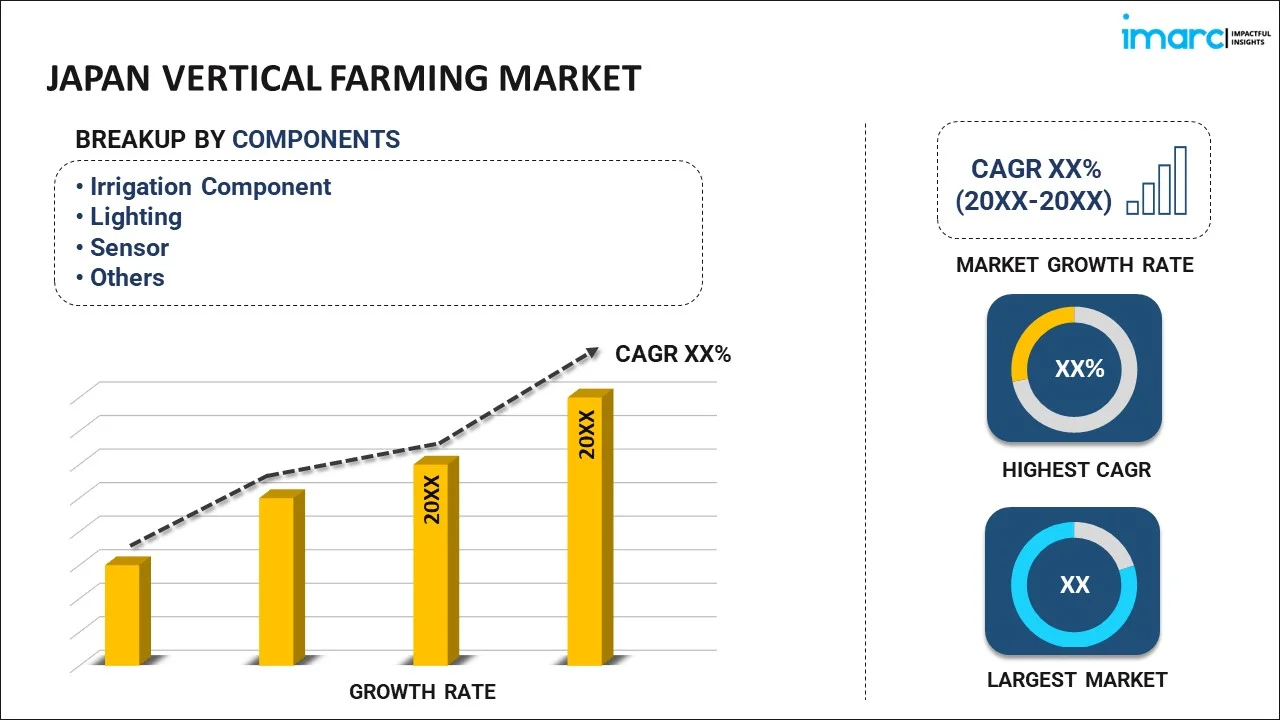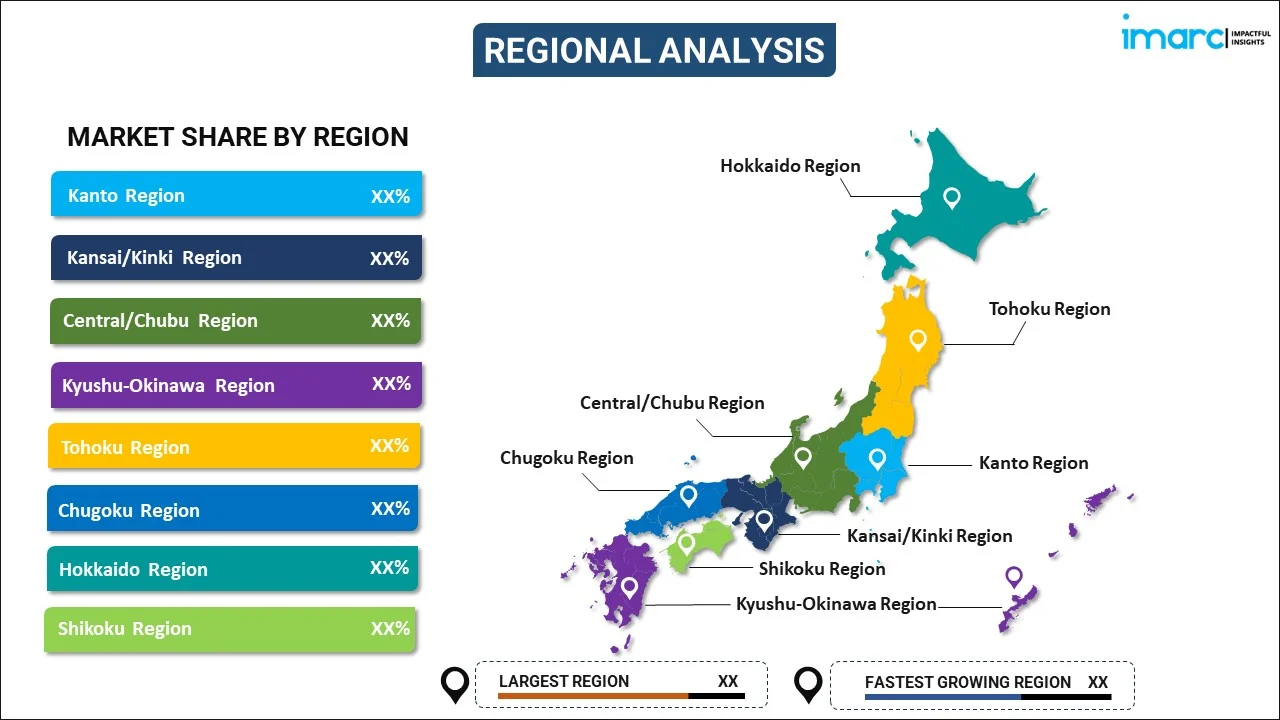
Japan Vertical Farming Market Report by Component (Irrigation Component, Lighting, Sensor, Climate Control, Building Material, and Others), Structure (Building-Based Vertical Farms, Container-Based Vertical Farms), Growth Mechanism (Hydroponics, Aeroponics, Aquaponics), Application (Indoor, Outdoor), and Region 2025-2033
Market Overview:
Japan vertical farming market size reached USD 402.0 Million in 2024. Looking forward, IMARC Group expects the market to reach USD 879.0 Million by 2033, exhibiting a growth rate (CAGR) of 9.1% during 2025-2033. The increasing prevalence of controlled environments in vertical farming that can minimize the need for chemical pesticides and herbicides, promoting sustainable and environmentally friendly farming practices, is primarily driving the market.
|
Report Attribute
|
Key Statistics
|
|---|---|
|
Base Year
|
2024 |
|
Forecast Years
|
2025-2033
|
|
Historical Years
|
2019-2024
|
| Market Size in 2024 | USD 402.0 Million |
| Market Forecast in 2033 | USD 879.0 Million |
| Market Growth Rate (2025-2033) | 9.1% |
Vertical farming refers to an innovative agricultural practice that maximizes crop production within a controlled indoor environment. Unlike traditional horizontal farms, vertical farming utilizes stacked layers or shelves to cultivate crops in a vertical arrangement, often inside buildings or specially designed structures. This approach optimizes space and resource usage while mitigating the limitations of traditional farming, such as climate dependency and land scarcity. Vertical farms employ advanced technologies like hydroponics or aeroponics to deliver essential nutrients and water to plants without soil. Additionally, LED lighting systems provide the necessary light for photosynthesis, enabling year-round cultivation. These controlled conditions enable precise environmental regulation, reducing the need for pesticides and conserving water. Vertical farming has several advantages, including increased crop yields, reduced land usage, lower transportation costs, and decreased environmental impact. It has the capacity to revolutionize food production in urban areas, addressing the growing challenges of population growth and food security while promoting sustainability and resource efficiency.
Japan Vertical Farming Market Trends:
The vertical farming market is gaining momentum in Japan due to several key drivers. To begin with, the increasing regional population and urbanization have put immense pressure on traditional agriculture to meet growing food demands. Consequently, vertical farming emerges as a sustainable solution to maximize crop yield in limited urban spaces, alleviating food scarcity concerns. Moreover, advancements in technology have played a pivotal role in propelling the vertical farming market forward. Innovations in automation, artificial intelligence, and LED lighting systems have boosted the efficiency and productivity of vertical farms, making them more economically viable. In addition to this, the growing awareness of environmental sustainability is driving the adoption of vertical farming. Consumers are highly concerned about the carbon footprint associated with conventional agriculture, leading to a shift towards eco-friendly and resource-efficient alternatives like vertical farming. Furthermore, the resilience of vertical farming against external factors, such as disease outbreaks and climate change, which ensure a more consistent and reliable food supply, is expected to drive the market in Japan during the forecast period.
Japan Vertical Farming Market Segmentation:
IMARC Group provides an analysis of the key trends in each segment of the market, along with forecasts at the country level for 2025-2033. Our report has categorized the market based on component, structure, growth mechanism, and application.
Component Insights:

- Irrigation Component
- Lighting
- Sensor
- Climate Control
- Building Material
- Glass Greenhouse
- Plastic Greenhouse
- Others
The report has provided a detailed breakup and analysis of the market based on the component. This includes irrigation component, lighting, sensor, climate control, building material (glass greenhouse and plastic greenhouse), and others.
Structure Insights:
- Building-Based Vertical Farms
- Container-Based Vertical Farms
A detailed breakup and analysis of the market based on the structure have also been provided in the report. This includes building-based vertical farms and container-based vertical farms.
Growth Mechanism Insights:
- Hydroponics
- Aeroponics
- Aquaponics
The report has provided a detailed breakup and analysis of the market based on the growth mechanism. This includes hydroponics, aeroponics, and aquaponics.
Application Insights:
- Indoor
- Outdoor
A detailed breakup and analysis of the market based on the application have also been provided in the report. This includes indoor and outdoor.
Regional Insights:

- Kanto Region
- Kansai/Kinki Region
- Central/ Chubu Region
- Kyushu-Okinawa Region
- Tohoku Region
- Chugoku Region
- Hokkaido Region
- Shikoku Region
The report has also provided a comprehensive analysis of all the major regional markets, which include Kanto Region, Kansai/Kinki Region, Central/ Chubu Region, Kyushu-Okinawa Region, Tohoku Region, Chugoku Region, Hokkaido Region, and Shikoku Region.
Competitive Landscape:
The market research report has also provided a comprehensive analysis of the competitive landscape in the market. Competitive analysis such as market structure, key player positioning, top winning strategies, competitive dashboard, and company evaluation quadrant has been covered in the report. Also, detailed profiles of all major companies have been provided.
Japan Vertical Farming Market Report Coverage:
| Report Features | Details |
|---|---|
| Base Year of the Analysis | 2024 |
| Historical Period | 2019-2024 |
| Forecast Period | 2025-2033 |
| Units | Million USD |
| Scope of the Report | Exploration of Historical Trends and Market Outlook, Industry Catalysts and Challenges, Segment-Wise Historical and Future Market Assessment:
|
| Components Covered |
|
| Structures Covered | Building-Based Vertical Farms, Container-Based Vertical Farms |
| Growth Mechanisms Covered | Hydroponics, Aeroponics, Aquaponics |
| Applications Covered | Indoor, Outdoor |
| Regions Covered | Kanto Region, Kansai/Kinki Region, Central/ Chubu Region, Kyushu-Okinawa Region, Tohoku Region, Chugoku Region, Hokkaido Region, Shikoku Region |
| Customization Scope | 10% Free Customization |
| Post-Sale Analyst Support | 9-11 Weeks |
| Delivery Format | PDF and Excel through Email (We can also provide the editable version of the report in PPT/Word format on special request) |
Key Questions Answered in This Report:
- How has the Japan vertical farming market performed so far and how will it perform in the coming years?
- What has been the impact of COVID-19 on the Japan vertical farming market?
- What is the breakup of the Japan vertical farming market on the basis of component?
- What is the breakup of the Japan vertical farming market on the basis of structure?
- What is the breakup of the Japan vertical farming market on the basis of growth mechanism?
- What is the breakup of the Japan vertical farming market on the basis of application?
- What are the various stages in the value chain of the Japan vertical farming market?
- What are the key driving factors and challenges in the Japan vertical farming?
- What is the structure of the Japan vertical farming market and who are the key players?
- What is the degree of competition in the Japan vertical farming market?
Key Benefits for Stakeholders:
- IMARC’s industry report offers a comprehensive quantitative analysis of various market segments, historical and current market trends, market forecasts, and dynamics of the Japan vertical farming market from 2019-2033.
- The research report provides the latest information on the market drivers, challenges, and opportunities in the Japan vertical farming market.
- Porter's five forces analysis assist stakeholders in assessing the impact of new entrants, competitive rivalry, supplier power, buyer power, and the threat of substitution. It helps stakeholders to analyze the level of competition within the Japan vertical farming industry and its attractiveness.
- Competitive landscape allows stakeholders to understand their competitive environment and provides an insight into the current positions of key players in the market.
Need more help?
- Speak to our experienced analysts for insights on the current market scenarios.
- Include additional segments and countries to customize the report as per your requirement.
- Gain an unparalleled competitive advantage in your domain by understanding how to utilize the report and positively impacting your operations and revenue.
- For further assistance, please connect with our analysts.
 Inquire Before Buying
Inquire Before Buying
 Speak to an Analyst
Speak to an Analyst
 Request Brochure
Request Brochure
 Request Customization
Request Customization




.webp)




.webp)












